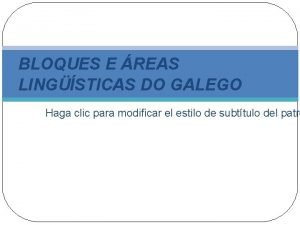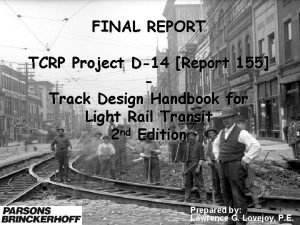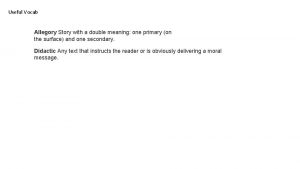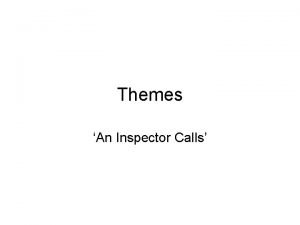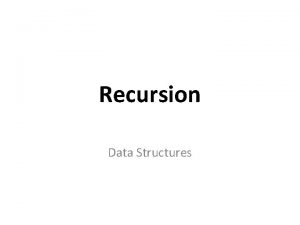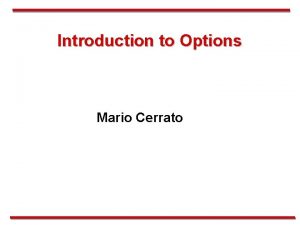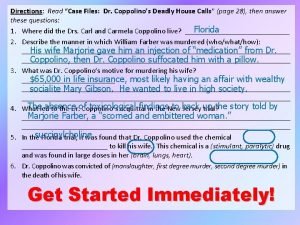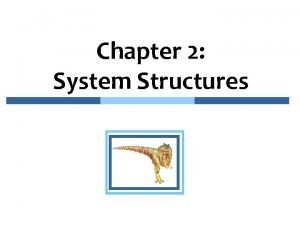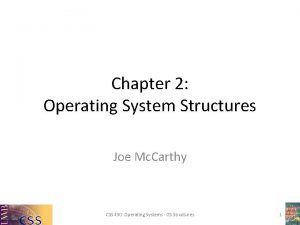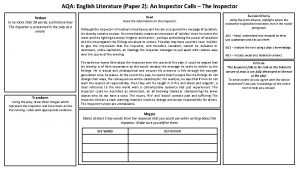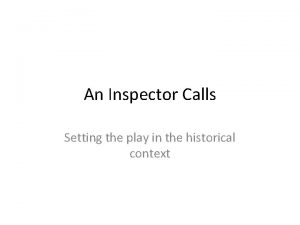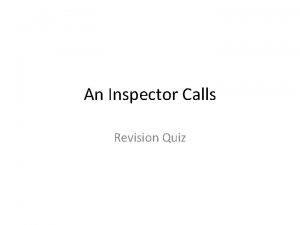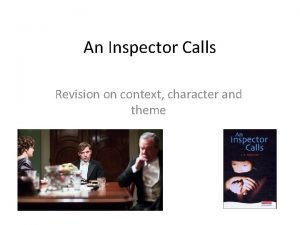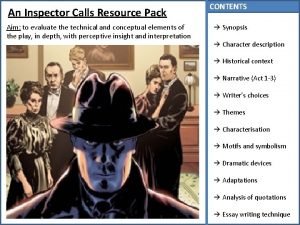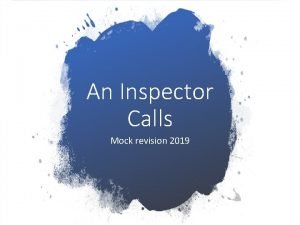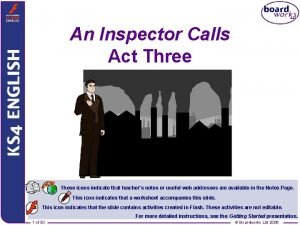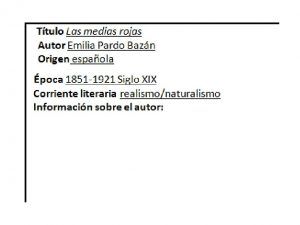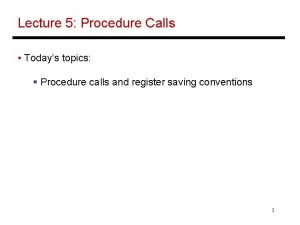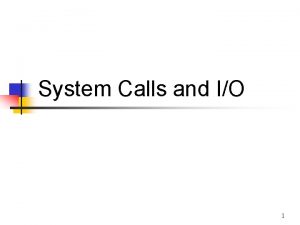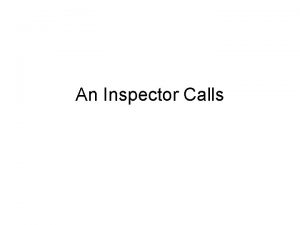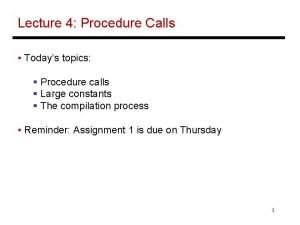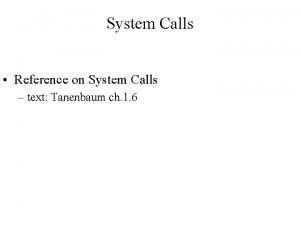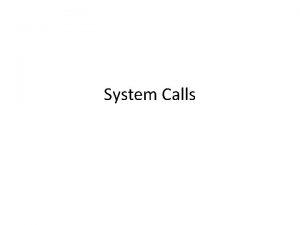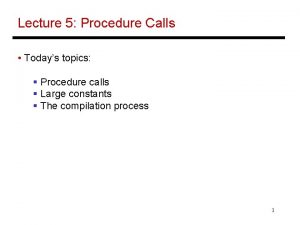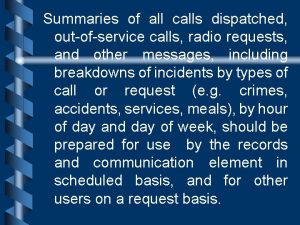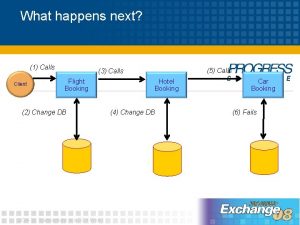Design Close Calls Rail Industry Forum Carlos Gallego








































- Slides: 40

Design Close Calls Rail Industry Forum Carlos Gallego – H&S Manager Network Rail Design Delivery Putting passengers first

Agenda item Presenter Role Paul Welford Chief Design Engineer Kobirul Mustafa Programme Manager What does a good DCC look like How do we raise a good DCC? Paul Guest & Daniel Pollitt Programme Engineering Manager & Programme Manager New Close Call System Liam Cooke Project Manager Carlos Gallego H&S Manager Shared Learning Christopher Walters Project Manager Shared Learning Ian Barry Design Team Manager Carlos Gallego H&S Manager Why are we here? Why do we need DCC? What data and information do we have? What’s next? Q&A - Survey Page 2 Putting passengers first

Why are we here? Paul Welford – Chief Design Engineer Page 3 Putting passengers first

Why are we here? • Network Rail and the Supply Chain collaboration - share and discuss DCC’s in the rail industry and how to progress • Design Close Call initially lead by Southern Shield & other groups (Northern Programs) • Common practise across the supply chain • Network Rail Design Delivery (NRDD) lead design organisation in Network Rail – Ownership and driving collaboration with NR Regions and Supply Chain. • Gathering of good practices across the rail industry, promote the principles, enhanced safety influence at design stage, safer industry • Improved collaboration, visible data, better analysis, consistent learning. Page 4 Putting passengers first

Activities so far 2017 -2018 DCC implemented by Southern Shield and used in other groups February 2019 NRDD to co-ordinate and lead DCC for the Rail Industry March – December 2019 January March NRDD leading DCC NRDD DCC data analysis • Review source material around principle • Create common place to access DCC information, guidance and dashboard data • Enhanced Close Call System for future data analysis • Supply Chain collaboration • More than 700 DCCs reviewed • DCC industry dashboard • Coordination with suppliers via DCC Rail Industry Forum • Liaison with existing groups to promote DCC Page 5 Putting passengers first

Why do we need Design Close Calls? Kobirul Mustafa – Programme Manager Page 6 Putting passengers first

• Whilst the reporting, capture and monitoring of Close Calls is widely used for site-based activities, they are not currently used effectively for design activities. • Understanding what hazards and risks are occurring during the design stages will allow us to take direct steps to reduce them in the future. This will improve the safety within all designs that are developed and subsequently reduce incidents and accidents during on-site activities. Page 7 Putting passengers first

Du. Pont – Bradley Curve Page 8 Putting passengers first

Should we still be designing equipment where the specified method of installation is a ‘four person lift’? Should this be considered a ‘safe’ temporary works access? Page 9 Putting passengers first

Definition • A design condition or situation (including errors and omissions) which could have been identified earlier in the design review / verification process • Something which has been signed off and subsequently found to have the potential to cause harm or injury to people or the environment • A design which harbours a latent hazard. This may be the result of design assumptions or option decisions which have not been adequately tested, managed or communicated. Page 10 Putting passengers first

Definition (Cont. ) • A set of parameters which places members of the project team under sufficient stress to endanger or damage their wellbeing or compromise their ability to fulfil their role effectively; this is likely but not necessarily the result of pressure to deliver on time. However there are other potential causes of stress which could be design or individual specific e. g. having to design to a bare minimum clearance. • It also allows for capturing observations of good and/or novel practice. Page 11 Putting passengers first

Process and Reporting Using Current Close Call System All close calls related to a design supplier’s activity should be raised within their close call system, as we do currently for site based issues. The RSSB system now includes a close call category for ‘Design’ When logging a Close Call, the main Category of 'DESIGN' should be used. Also include the Sub-Category the Close Call can be related to. This will then allow a download to be taken of those Close Calls specifically related to Design from the RSSB system to allow detailed analysis Page 12 Putting passengers first

Barriers and challenges to raising DCC’s • Culture • Leadership across all organisations will be critical in achieving a positive culture around design Close Calls. • It is everyone's responsibility to create a positive, no blame culture around design Close Calls. • Design close calls must not be used as a means to criticise and penalise individuals; the focus should be on identifying and learning from failures in process. • The Close Call process is an opportunity to develop and share learning and the initiator and owner of the issue should engage with each other in a collaborative, learning spirit, to agree a proposed course of action • Raising design Close Calls needs to be actively reinforced as a positive behaviour at all levels of designer, principle contractor and client organisations. • Design close calls are no different to site close calls in terms of the importance of collecting information to drive safety improvement • System Page 13 Putting passengers first

What does a good Design Close Call look like? Paul Guest - Programme Engineering Manager Page 14 Putting passengers first

The Challenge • The biggest challenge is being able recognising a Design Close Call • The Definitions of a Design Close Call give the foundations • Key is being able to differentiate between normal business and a Design Close Call. • Common difficulty “Identifying errors is part of normal company governance and assurance processes e. g. design development DRN’s and construction red lines? ” • Process are there to help us get designs right and not put pressure on staff. • Generally Design Close Call’s should capture when these processes fail or there are unexpected results. • The aim of capturing Design Close Calls is to improve and ideally sharing this information for other to improve – e. g. Significant Event Procedure. Page 15 Putting passengers first 15

Good Practice when capturing a Design Close Calls Three key bits of information • Understand the context and include that in the description • Attempt to understand the impact and what could have happened • Take the action or recommend an action that has the potential to stop the error happening • OR In the case of a good practice recommend how it can be repeated or shared Page 16 Putting passengers first

Design Close Calls - Examples Not using all available information – raised by PM team Description: A DRN was created for a CR 2 drainage report, and one of the comments was questioning whether the Geo-RINM drainage layer was used to inform the report. The DRN response was that they were unaware that this layer existed in Geo-RINM. This shows that the design team do not know about all the survey/existing information they have. What could have happened: This could have led to presenting land boundaries at consultation which shows additional land take into properties not accounted for. Action required: 1) Brief design team on all the different layers available in Geo-RINM. 2) Encourage a behaviour whereby designers are checking all sources of data. Page 17 Putting passengers first

Design Close Calls - Examples Putting Pressure on design team – Raised by PM Description: I put undue pressure on the design team to review and issue a design in a very short time scales. This meant people were updating models ‘live’ as opposed to developing in their own time and then integrating in to the overall model. I also asked for draft, non approved designs to be sent out for impact assessing. What could have happened: Different items could have been missed (such as worksites potentially not being suitable to construct the design) as no time was given to fully understand the impact of the any changes on their discipline. Further, had the designs been shared for impact assessing in draft, items could have been missed, and not potentially have a knock on impact further along the design/construction process. In addition to all of this, it is against the design review and approval process which ultimately exists to ensure all designs are fully integrated and safe Action required: Postpone pairwise meeting and change control to allow sufficient time to undertake work. Page 18 Putting passengers first 18

How do we raise a good DCC? Daniel Pollitt - Programme Manager Page 19 Putting passengers first

Page 20 Putting passengers first

Page 21 Putting passengers first

Page 22 Putting passengers first

Page 23 Putting passengers first

Page 24 Putting passengers first

Page 25 Putting passengers first

New Close Call System Liam Cooke – Project Manager Page 26 Putting passengers first

Current system • Close Call System is ‘unfit for purpose’ to deliver business needs today • Processing of a close call can take 2 weeks from notification • Non existent analytics restrict any form of useful intelligence • 7 FTEs process close calls – along with licences and operating system costs £ 750 k/yr. Not value for money Replacement system • Instant processing of close calls • User experience will reflect a modern web based system • Instant ownership for managers and those who raise close call to track progress • Administration and hierarchy management of close calls can be administered within the routes – reduces cost • Excellent business analytics to help target proactive risk controls Benefits • Platform will be managed in house - reducing running costs • Advanced analysis and reporting, allowing for better understanding of Close Call data and learning of potential risks • App not restricted to Network Rail devices, but open to Supply Chain and Railway Industry partners • New e-learning portfolio with materials for users of all levels accessing the system • Frontline workers will have ability to view and process close calls via App, visibility of close calls whilst preparing SSOW packs or carry ‘Take 5’ briefings Page 27 Putting passengers first

New Functionality • Data and Analysis - Live data dashboard bespoke to each users’ geographical focus and area of responsibility will allow for instant visibility of close calls • Pre-mapped location interfaces - Pre populated location details allowing instant allocation of close call • Mobile App and Web App users profiles – notifications as close call moves through each stage • Forgotten Password facility – reset facility reducing need to contact close call team • Visible location map - reporting showing plots of all Close Calls with filter facility • Pre-configured SLA – will provide enhanced audit trial of close calls within each Region/Route/Function and visibility of resolution against pre-defined SLAs • Early Warning Indicator – scope to link triggers with other applications (Risk Assurance Level 1 and Incident Investigation) to warn of potential incidents Timelines (TBC) • High level timelines are • Start Procurement May 2020 (Timescales removed as it’s under review) • Solution Designoff September 2020 • Testing February 2020 • New System Go live April 2021 Page 28 Putting passengers first

What data and information do we have? Carlos Gallego – Health and Safety Manager Page 29 Putting passengers first

DCC - Safety Central To access DCC page please go to Safety Central – Safety – Close Call and select DCC at the right-hand site! Page 30 Putting passengers first

DCC Dashboard Page 31 Putting passengers first

Shared Learning 1 Christopher Walters – Project Manager Page 32 Putting passengers first

Design Close Call Example Incident: Following construction review there was confirmation that a new version of track design was available. This was not formally issued with notes to highlight changes. What Could Have Happened? • Land take at consultation does not reflect required land take • Two alignments do not align for consultation • Impact to the bridge due to change of track alignment which has not been reviewed Actions taken: • Highlighted in design issue tracker and review during the next design stage • Agreed approach for implementing and issuing documents Lessons Learned: • With a number of interfaces, understand how this will be controlled and agree approach for each stage • Clear understanding of changes through workshops and followed by report Page 33 Putting passengers first

Shared Learning Page 34 Putting passengers first

Shared Learning 2 Ian Barry – Design Team Manager Page 35 Putting passengers first

Design Close Call Example Action points: Ensure you are using the source record for your design or a parallel design agreement is in place. In the case of late notice or ‘emergency’ designs ensure you are aware of all potential schemes within or in the vicinity of your designs. When considering correlation waivers ensure that the validity and age of the survey data being used in lieu of correlation is carefully considered. Discussion points: • Are you using the most up to date source information for your designs? • Are you aware of parallel works being undertaken, including in late notice & emergency design situations? If not then consult with the asset owners – If you don’t ask, you won’t know! • Is a correlation required or have you got a correlation waiver? • Is the accuracy of source information as important as the accuracy of the proposed design? [It’s a rhetorical question!] Page 36 Putting passengers first

What’s next? Page 37 Putting passengers first

DCC Rail Industry Forum - What’s next? July DCC Rail Industry Forum Online survey August September Review of feedback, proposals and analysis of data November Central DCC Shared Learning site Page 38 January 2 nd Rail Industry Forum April New Close Call System Putting passengers first

Q&A & Survey Share with us your thoughts! Just open your camera and an select the link when prompted! Page 39 Putting passengers first

 Network rail close call
Network rail close call Define bulk reducing industry
Define bulk reducing industry Joseph g christopher
Joseph g christopher Tincion monocromica
Tincion monocromica Seseo implosivo e explosivo
Seseo implosivo e explosivo Fernando gallego dias
Fernando gallego dias Musico gallego
Musico gallego Alejandro gallego schmid
Alejandro gallego schmid Cecilia gallego
Cecilia gallego Luis jos gallego
Luis jos gallego David montes gallego
David montes gallego Tcrp report 155
Tcrp report 155 Is an inspector calls an allegory
Is an inspector calls an allegory Themes in an inspector calls
Themes in an inspector calls It is a repetitive process in which algorithm calls itself.
It is a repetitive process in which algorithm calls itself. Us it recruiter call script
Us it recruiter call script Rocket sweep playbook
Rocket sweep playbook Nested macro calls
Nested macro calls Definition of calls and puts
Definition of calls and puts Deadly house calls
Deadly house calls Tacoma fire department calls
Tacoma fire department calls Gerald croft character traits
Gerald croft character traits Operating system structure
Operating system structure Device management system calls
Device management system calls Bopm counter
Bopm counter Semantics of call and return in ppl
Semantics of call and return in ppl Inspector calls mark scheme
Inspector calls mark scheme 1912 strikes an inspector calls
1912 strikes an inspector calls Inspector calls quotes
Inspector calls quotes An inspector calls context timeline
An inspector calls context timeline An inspector calls character
An inspector calls character Inspector calls summary act 2
Inspector calls summary act 2 An inspector calls recall questions
An inspector calls recall questions An inspector calls summary
An inspector calls summary Giving us the port edna
Giving us the port edna Inspector calls wordsearch
Inspector calls wordsearch A monster calls chapter 2
A monster calls chapter 2 Catcher in the rye chapter 13-15 summary
Catcher in the rye chapter 13-15 summary Travel sales calls
Travel sales calls Method that calls itself
Method that calls itself John 15:9-11
John 15:9-11




